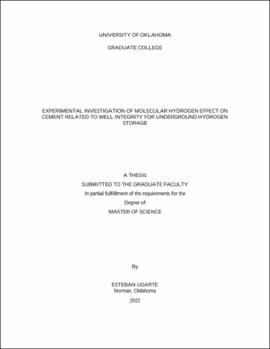| dc.contributor.advisor | Salehi, Saeed | |
| dc.contributor.author | Ugarte Daza, Esteban Rolando | |
| dc.date.accessioned | 2022-12-08T22:25:46Z | |
| dc.date.available | 2022-12-08T22:25:46Z | |
| dc.date.issued | 2022 | |
| dc.identifier.uri | https://hdl.handle.net/11244/336895 | |
| dc.description.abstract | Underground Hydrogen Storage (UHS) in the subsurface is an alternative to overcome limitations associated with a fluctuating production of renewable energy sources. The excess energy produced can be converted to hydrogen and stored in porous media. Hydrogen is injected and produced from geological formations via wells. There are several concerns regarding the interactions of hydrogen with the different well components responsible for maintaining proper well integrity, such as cement. This experimental study investigates the interaction between molecular hydrogen and cement Class H. The methodology provides a comparison of experimental tests to highlight the effects hydrogen can have on cement during aging. Samples were cured in two different environments were then characterized using different physical and chemical tests such as Unconfined Compressive Strength (UCS), Fourier Transform Infrared Spectroscopy (FTIR), Porosity and Permeability (PP), Nuclear Magnetic Resonance (NMR), Scanning Electron Microscopy (SEM) and Energy Dispersive X-Ray Spectroscopy (EDS). Samples exposed to molecular hydrogen exhibited a greater compressive strength in both the short and long terms. Porosity was found to be lower in samples exposed to hydrogen. Similarly, permeability was lower in samples exposed to hydrogen. NMR distributions showed a reduction of larger pores and an increase of smaller pore spaces. The compositional analysis demonstrated that hydrogen presence increases the amount of hydrated product (portlandite and ettringite) formed. The crystalline needle-shaped structure observed in the SEM confirmed the presence of portlandite and ettringite within some of the larger pores. Acoustic velocities showed hydrogen- exposed samples to be stiffer and less flexible. This could be detrimental because, during UHS, cement is exposed to multiple cycles of injection and production. This experimental study showed that molecular hydrogen present could generate the formation of hydrated products, causing a shift in the porosity distribution affecting the mechanical strength of the cement. | en_US |
| dc.language | en_US | en_US |
| dc.subject | Engineering, Petroleum. | en_US |
| dc.subject | Underground Hydrogen Storage | en_US |
| dc.subject | Well Integrity | en_US |
| dc.subject | Cement testing | en_US |
| dc.title | Experimental Investigation of Molecular Hydrogen Effect on Cement Related to Well Integrity for Underground Hydrogen Storage | en_US |
| dc.contributor.committeeMember | Nygaard, Runar | |
| dc.contributor.committeeMember | Moghanloo, Rouzbeh | |
| dc.date.manuscript | 2022-12-07 | |
| dc.thesis.degree | Master of Science | en_US |
| ou.group | Mewbourne College of Earth and Energy::Mewbourne School of Petroleum and Geological Engineering | en_US |
| shareok.nativefileaccess | restricted | en_US |
